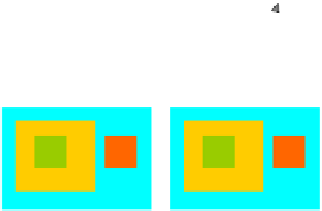Information Technology Reference
In-Depth Information
view connection. A shared copy of a composite pad can be defined as shown in
Figure 5. Each pad or composite pad embedded in a shared copy of a base pad can be
interpreted to work as a modification of the view of this copy.
independent copies
Composite
pad P'
Composite
pad P
M
the model of the base pad
shared copies
P
P'
Fig. 5.
Shared copies of a composite pad
In order to make each pad pluggable, i.e., be coded independently from the pad to
which it is connected, each reference to a specific function of the pad to be connected
should be specified in an indirect way. Such a reference in the coding should
internally use a parameter, which is bound to the specific function of the pad to be
connected when the connection is defined at composition time. The specific function
of the pad to be connected is identified by a pair of the pad identifier and its function
name. Our synthetic media architecture represents each function of a pad as its input
and/or output port, which we call its slot. Each slot is identified by its name. In order
to access a slot, our architecture provides two standard messages, i.e., “set” and
“gimme” messages. The “set” message may take two parameters, i.e., a slot name and
a value to be sent to the slot. The “gimme” message takes one parameter to specify a
slot. These two messages when used in coding of a pad need not specify their slot
parameters. When a pad is pasted on another pad, the system asks the user to which
slot of the parent pad it is connected. The user can just specify one of the slots of the
parent. This slot of the parent pad is called the connection slot. The slot-name
parameters of a “set” message and a “gimme” message are automatically added as the
name of the connection slot when these messages are issued to the parent pad. The
parent-child connection also uses the “update” message which notifies the update of
the parent pad to all of its child pads. This message takes no parameter. The default
usage of the set message is to send a value from a pad to its parent pad, while the
default usage of the other two messages is to get the new value of the connection slot
whenever its parent pad is updated. Figure 6 shows a pad connection with standard
messages between two pads.




































